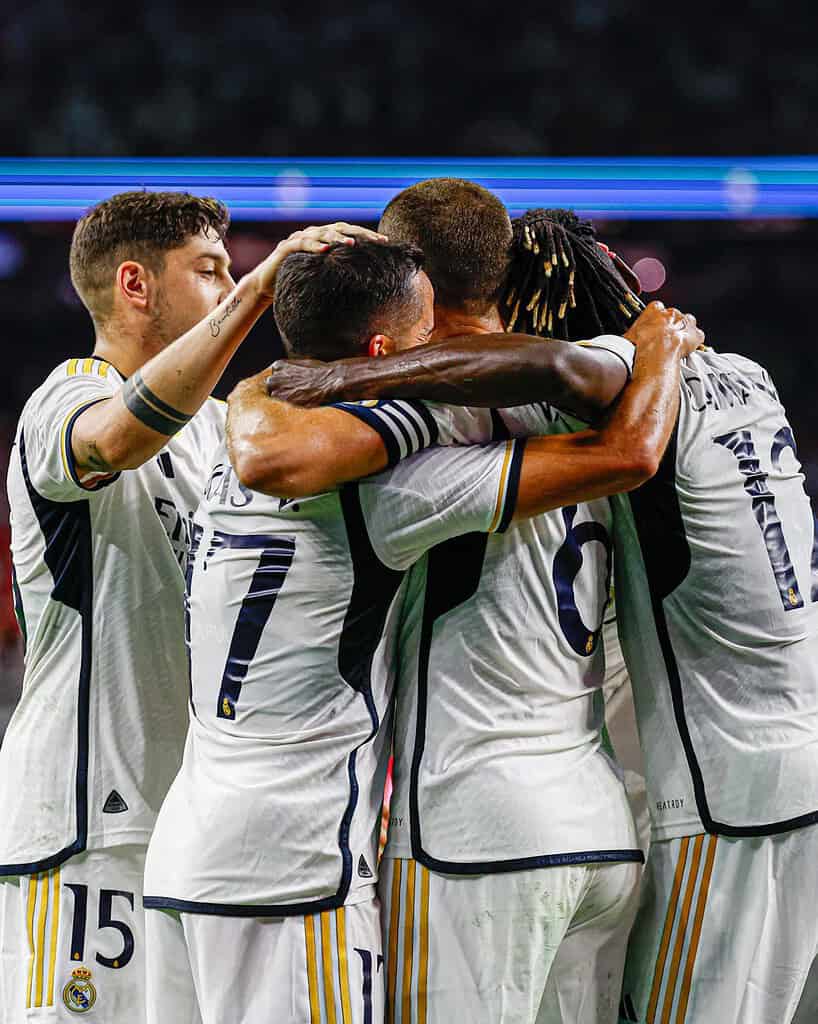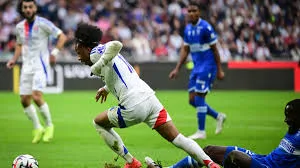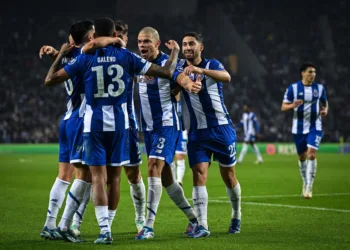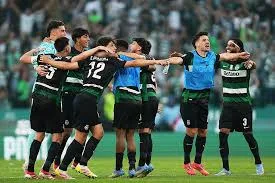In the previous season, Barcelona, the bitter rivals of Real Madrid, reclaimed the La Liga title after a four-year gap. However, this outcome is unsatisfactory. We now examine five inquiries that Carlo Ancelotti must address in order to steer Madrid back onto the right path.

Read More: Analysing Real Madrid’s Tactical Evolution: The 442 Diamond and its Prospects for Success
What Strategies Can Real Madrid Employ to Fill the Void Left by Karim Benzema?
The straightforward solution to this query would be Kylian Mbappé, although it is also the most costly option. At present, Real Madrid’s plan is to replace one of their greatest goal scorers with Joselu, a 33-year-old loaned from Espanyol.
On a technical level, this is what has transpired. However, in reality, we can anticipate an entirely revamped Real Madrid in the upcoming season.

Carlo Ancelotti intends to alter his tactical approach, introducing more dynamic elements to the attack than we have witnessed in recent years. Jude Bellingham will assume the role at the apex of a 4-4-2 diamond formation, while Vinícius Júnior will be tasked with drifting inside more frequently, transitioning from a conventional winger to a second striker.
In the previous season, Real Madrid managed to net a total of 127 goals across various competitions. Out of those, Benzema contributed 31, roughly accounting for a quarter of the tally. Vinícius recorded 23 goals, and Rodrygo scored 19 in competitive matches. With Benzema no longer leading the penalty area charge, these two players should have increased opportunities to find the net.
They will be expected to shoulder a greater share of the goal-scoring responsibility in the upcoming season, along with the newly acquired Bellingham. The English midfielder significantly boosted his goal count from six in 2021-22 to 14 in 2022-23 across all competitions for Borussia Dortmund, and similar expectations for his goal-scoring output are set for his tenure at Real Madrid next season.

Apart from Benzema’s goal-scoring prowess, another critical element that Madrid will deeply feel his absence is how he positioned himself as the heart of their offensive strategies. Even when not directly engaged in a play, everything seemed to revolve around him. He functioned as the central figure, influencing the team’s dynamics. Vinícius and Rodrygo understood how to coordinate their actions based on Benzema’s positioning, and the midfielders timed their runs in accordance with the movements of the French striker. With their focal point now absent, Real Madrid faces the task of reimagining their approach without their cornerstone.
The duration required for this adjustment and the effectiveness with which each player embraces their new role will significantly shape Real Madrid’s season ahead.
In Which Position is Jude Bellingham Expected to Take the Field?
In Spain, there’s a phrase “tiene gol,” which translates to “he has goal.” It’s not exactly like the English expression “he’s got goals in him,” but more intrinsic, akin to describing someone as tall. It’s like saying “Jude Bellingham has goal.”
He is anticipated to tally a substantial number of goals in the upcoming season.
Now, the question arises – where will he play? Ancelotti has already addressed this inquiry for us.

“When I began my coaching journey, I had a distinct vision of how I wanted to play, and I didn’t adapt to my players. I had an experience at Parma where [Roberto] Baggio wanted to play as the number 10, and I didn’t alter the system,” Ancelotti remarked. “He eventually moved to another team. And I made a mistake. At Juventus, alongside [Zinedine] Zidane, I started to comprehend that it’s wiser to adjust to the players.”
This quote is noteworthy for a variety of reasons. Firstly, it provides a clear indication of Bellingham’s designated role – as a number 10. But more significantly, it sheds light on the caliber of players Ancelotti is comparing Bellingham to.
Though Real Madrid has been rooted in a 4-3-3 formation for a long time, this will change in the upcoming season.

Bellingham embodies a Baggio, a Zidane. He is the type of player around whom you reshape your tactics, even requiring Vinícius to adapt. This squad is brimming with exceptional talent, yet Real Madrid recognizes the exceptionally extraordinary talent they possess in Bellingham. This carries a weighty responsibility. He will operate as a number 10, yet his influence will extend across the field, just as demonstrated in the three pre-season friendlies he has participated in this summer.
Who Will Provide Vinícius With a Chance to Rest?
During the previous season, Vinícius Júnior accumulated a total of 4,755 minutes on the field. In all competitions across Europe’s top five leagues, only David de Gea and Bruno Fernandes surpassed this playing time. This can be attributed partly to his crucial role within the team, as well as the absence of a viable substitute on the bench.

This summer, Real Madrid secured the acquisition of Arda Güler, who, despite being just 18 years old, may find himself logging more playing time than even Eden Hazard did – a task that wouldn’t prove challenging.
Furthermore, the transition to a 4-4-2 diamond formation implies that the replacement for Vinícius doesn’t necessarily need to be a left winger, particularly since there is a scarcity of such players within the current squad.

The subsequent aspect of this inquiry revolves around how the Brazilian player will fit into the new style. Real Madrid has invested significant resources in Bellingham, evidently regarding him as the type of midfielder around whom a tactical framework can be constructed. Even in the context of preseason matches, his significance has been evident, and with Benzema’s departure, Bellingham’s role becomes even more pronounced.
Consequently, Vinícius might need to adjust to this novel system. The extent to which he accomplishes this adaptation remains to be seen, and time will be the ultimate judge. Nonetheless, it’s evident that if he continues accumulating playing time as he has since solidifying his position in the Madrid lineup, it won’t be long before we observe a decrease in the heightened intensity that has been a hallmark of his style of play.
Which Midfield Combination Should be Considered the Most Optimal for Carlo Ancelotti’s Real Madrid?
Is it possible to have an excess of world-class midfielders?
Within the framework of a 4-4-2 formation, assuming Bellingham takes the starting position, there are three midfield slots available. Toni Kroos, Luka Modric, Dani Ceballos, Aurélien Tchouaméni, Eduardo Camavinga, and Fede Valverde are all competing for playing time. A significant aspect of Zidane’s achievements at Real Madrid stemmed from his skill in distributing playing time fairly while maintaining a cohesive core team and keeping bench players content.

Florentino Perez has invested over €250 million in Bellingham, Tchouaméni, and Camavinga, implying that these three are expected to eventually form the nucleus of the team.
However, the question remains: when will this transition occur? Kroos and Modric have both extended their contracts by one year and might be content with reduced playing time, but there is a limit to their patience. While they are in the latter stages of their careers, they still possess considerable skill, making it challenging to resist starting them when they are fit.

Ancelotti will need to find the right equilibrium in the midfield for the upcoming season. Many of the aforementioned players share similarities, yet each possesses unique strengths and weaknesses. With an abundance of options at hand, selecting the optimal midfield combination for key matches will prove pivotal to their success in the upcoming season.
Can Real Madrid’s Full-Back Situation be Sustained?
Real Madrid’s squad currently features only one dedicated right-back, Dani Carvajal. Lucas Vázquez is often deployed in that role when needed, and Nacho has also filled in as a right-back on occasion.

At 31 years old, Carvajal has contributed years of dynamic runs down the right flank and there’s a pressing need for a natural successor. On the opposite side, Fran García returned after an impressive season at Rayo Vallecano, and Ferland Mendy is another contender for the left-back position in the upcoming season.
With David Alaba, Antonio Rüdiger, Éder Militão, and Nacho available as center-back options, Real Madrid appears well-covered in the heart of their defense. However, the shortage of full-back options could potentially pose a challenge.

Camavinga spent much of the previous season playing at left-back, primarily providing defensive support for Vinicius Jr. and aiding in build-up play as an additional midfielder. The new tactical system under Ancelotti allows Camavinga to continue offering this support without being restricted to the left-back role. During pre-season, he has been positioned as a left midfielder in a 4-4-2 formation, hinting at a potential breakthrough season for the young talent.
However, in a compact 4-4-2 diamond formation, the full-backs will be required to contribute both offensively by stretching the play wide and defensively by ensuring their coverage responsibilities are met.

Can Carvajal sustain this demanding role throughout the entire season without a suitable natural successor? Are we confident that García (who has demonstrated promise in pre-season) or Mendy can perform at a similarly elevated level on the left?
This particular zone of the field could potentially present challenges for Madrid in the upcoming season.








